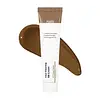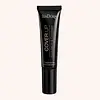What's inside
What's inside
 Key Ingredients
Key Ingredients

 Benefits
Benefits

 Concerns
Concerns

 Ingredients Side-by-side
Ingredients Side-by-side

Water
Skin ConditioningCI 77492
Cosmetic ColorantEthylhexyl Methoxycinnamate
UV AbsorberButylene Glycol
HumectantCyclopentasiloxane
EmollientEthylhexyl Salicylate
UV AbsorberLauryl Polyglyceryl-3 Polydimethylsiloxyethyl Dimethicone
Skin ConditioningHydrogenated Poly(C6-14 Olefin)
EmollientNiacinamide
SmoothingZinc Oxide
Cosmetic ColorantCyclohexasiloxane
EmollientCI 77891
Cosmetic ColorantCI 77491
Cosmetic ColorantCI 77499
Cosmetic ColorantSodium Chloride
MaskingDisteardimonium Hectorite
StabilisingSorbitan Sesquioleate
EmulsifyingMica
Cosmetic ColorantTriethoxycaprylylsilane
Zinc Stearate
Cosmetic ColorantDextrin Palmitate
EmulsifyingCaprylyl Glycol
EmollientPanthenol
Skin ConditioningAllantoin
Skin ConditioningCentella Asiatica Extract
CleansingDimethicone/Vinyl Dimethicone Crosspolymer
Skin ConditioningAluminum Hydroxide
EmollientCaprylhydroxamic Acid
Glycerin
HumectantAdenosine
Skin Conditioning1,2-Hexanediol
Skin ConditioningTocopherol
AntioxidantMadecassoside
AntioxidantAsiaticoside
AntioxidantAsiatic Acid
Skin ConditioningMadecassic Acid
Skin ConditioningWater, CI 77492, Ethylhexyl Methoxycinnamate, Butylene Glycol, Cyclopentasiloxane, Ethylhexyl Salicylate, Lauryl Polyglyceryl-3 Polydimethylsiloxyethyl Dimethicone, Hydrogenated Poly(C6-14 Olefin), Niacinamide, Zinc Oxide, Cyclohexasiloxane, CI 77891, CI 77491, CI 77499, Sodium Chloride, Disteardimonium Hectorite, Sorbitan Sesquioleate, Mica, Triethoxycaprylylsilane, Zinc Stearate, Dextrin Palmitate, Caprylyl Glycol, Panthenol, Allantoin, Centella Asiatica Extract, Dimethicone/Vinyl Dimethicone Crosspolymer, Aluminum Hydroxide, Caprylhydroxamic Acid, Glycerin, Adenosine, 1,2-Hexanediol, Tocopherol, Madecassoside, Asiaticoside, Asiatic Acid, Madecassic Acid
Water
Skin ConditioningDimethicone
EmollientIsohexadecane
EmollientIsononyl Isononanoate
EmollientZinc Stearate
Cosmetic ColorantCaprylyl Dimethicone Ethoxy Glucoside
EmulsifyingDimethicone Crosspolymer
Emulsion StabilisingSorbitan Isostearate
EmulsifyingSqualane
EmollientGlycerin
HumectantButylene Glycol
HumectantAluminum/Magnesium Hydroxide Stearate
Emulsion StabilisingPhenoxyethanol
PreservativeSodium Chloride
MaskingHexylene Glycol
EmulsifyingPotassium Sorbate
PreservativeSodium Dehydroacetate
PreservativeTocopheryl Acetate
AntioxidantMica
Cosmetic ColorantFructose
HumectantGlucose
HumectantBetaine
HumectantAlbizia Julibrissin Bark Extract
MaskingPentylene Glycol
Skin ConditioningSaccharomyces Cerevisiae Extract
Skin ConditioningDextrin
AbsorbentSucrose
HumectantUrea
BufferingRhodiola Rosea Root Extract
EmollientAlanine
MaskingAspartic Acid
MaskingGlutamic Acid
HumectantSodium Benzoate
MaskingDarutoside
Skin ConditioningCI 77891
Cosmetic ColorantCI 77492
Cosmetic ColorantCI 77491
Cosmetic ColorantCI 77499
Cosmetic ColorantWater, Dimethicone, Isohexadecane, Isononyl Isononanoate, Zinc Stearate, Caprylyl Dimethicone Ethoxy Glucoside, Dimethicone Crosspolymer, Sorbitan Isostearate, Squalane, Glycerin, Butylene Glycol, Aluminum/Magnesium Hydroxide Stearate, Phenoxyethanol, Sodium Chloride, Hexylene Glycol, Potassium Sorbate, Sodium Dehydroacetate, Tocopheryl Acetate, Mica, Fructose, Glucose, Betaine, Albizia Julibrissin Bark Extract, Pentylene Glycol, Saccharomyces Cerevisiae Extract, Dextrin, Sucrose, Urea, Rhodiola Rosea Root Extract, Alanine, Aspartic Acid, Glutamic Acid, Sodium Benzoate, Darutoside, CI 77891, CI 77492, CI 77491, CI 77499
 Reviews
Reviews

Ingredients Explained
These ingredients are found in both products.
Ingredients higher up in an ingredient list are typically present in a larger amount.
Butylene Glycol (or BG) is used within cosmetic products for a few different reasons:
Overall, Butylene Glycol is a safe and well-rounded ingredient that works well with other ingredients.
Though this ingredient works well with most skin types, some people with sensitive skin may experience a reaction such as allergic rashes, closed comedones, or itchiness.
Learn more about Butylene GlycolCi 77491 is also hydrated iron III oxide. It's sole purpose is to give a red/pink hue to products.
Iron III oxides are classified as inorganic chemicals for coloring.
Synthetically created Ci 77491 is considered safer than those naturally found. This is because the synthetically created version may contain less impurities. Iron oxides are generally non-toxic and non-allergenic.
Learn more about CI 77491Ci 77492 is also hydrated iron III oxide. It's sole purpose is to give a yellow hue to products.
Iron III oxides are classified as inorganic chemicals for coloring.
Synthetically created Ci 77492 is considered safer than those naturally found. This is because the synthetically created version may contain less impurities. Iron oxides are generally non-toxic and non-allergenic.
Learn more about CI 77492Ci 77499 is also hydrated iron III oxide. It is created from mixing red and black iron oxides. This helps give shades of darkness to a product.
Iron III oxides are classified as inorganic chemicals for coloring.
Ci 77891 is a white pigment from Titanium dioxide. It is naturally found in minerals such as rutile and ilmenite.
It's main function is to add a white color to cosmetics. It can also be mixed with other colors to create different shades.
Ci 77891 is commonly found in sunscreens due to its ability to block UV rays.
Learn more about CI 77891Glycerin is already naturally found in your skin. It helps moisturize and protect your skin.
A study from 2016 found glycerin to be more effective as a humectant than AHAs and hyaluronic acid.
As a humectant, it helps the skin stay hydrated by pulling moisture to your skin. The low molecular weight of glycerin allows it to pull moisture into the deeper layers of your skin.
Hydrated skin improves your skin barrier; Your skin barrier helps protect against irritants and bacteria.
Glycerin has also been found to have antimicrobial and antiviral properties. Due to these properties, glycerin is often used in wound and burn treatments.
In cosmetics, glycerin is usually derived from plants such as soybean or palm. However, it can also be sourced from animals, such as tallow or animal fat.
This ingredient is organic, colorless, odorless, and non-toxic.
Glycerin is the name for this ingredient in American English. British English uses Glycerol/Glycerine.
Learn more about GlycerinMica is a naturally occurring mineral used to add shimmer and color in cosmetics. It can also help improve the texture of a product or give it an opaque, white/silver color.
Serecite is the name for very fine but ragged grains of mica.
This ingredient is often coated with metal oxides like titanium dioxide. Trace amounts of heavy metals may be found in mica, but these metals are not harmful in our personal products.
Mica has been used since prehistoric times throughout the world. Ancient Egyptian, Indian, Greek, Roman, Aztec, and Chinese civilizations have used mica.
Learn more about MicaChances are, you eat sodium chloride every day. Sodium Chloride is also known as table salt.
This ingredient has many purposes in skincare: thickener, emulsifier, and exfoliator.
You'll most likely find this ingredient in cleansers where it is used to create a gel-like texture. As an emulsifier, it also prevents ingredients from separating.
There is much debate on whether this ingredient is comedogenic. The short answer - comedogenic ratings don't tell the whole story. Learn more about comegodenic ratings here.
The concensus about this ingredient causing acne seems to be divided. Research is needed to understand if this ingredient does cause acne.
Scrubs may use salt as the primary exfoliating ingredient.
Learn more about Sodium ChlorideWater. It's the most common cosmetic ingredient of all. You'll usually see it at the top of ingredient lists, meaning that it makes up the largest part of the product.
So why is it so popular? Water most often acts as a solvent - this means that it helps dissolve other ingredients into the formulation.
You'll also recognize water as that liquid we all need to stay alive. If you see this, drink a glass of water. Stay hydrated!
Learn more about WaterZinc Stearate is the metal salt of stearic acid. It is a white solid used to bind, thicken, and lubricate products.
This ingredient is common in powder makeup, where it helps keep the powder together.
Zinc Stearate is hydrophobic and repels water.
This ingredient can be sourced from non-animal or animal sources. It is best to reach out to the brand to see where they source this ingredient from.
Learn more about Zinc Stearate